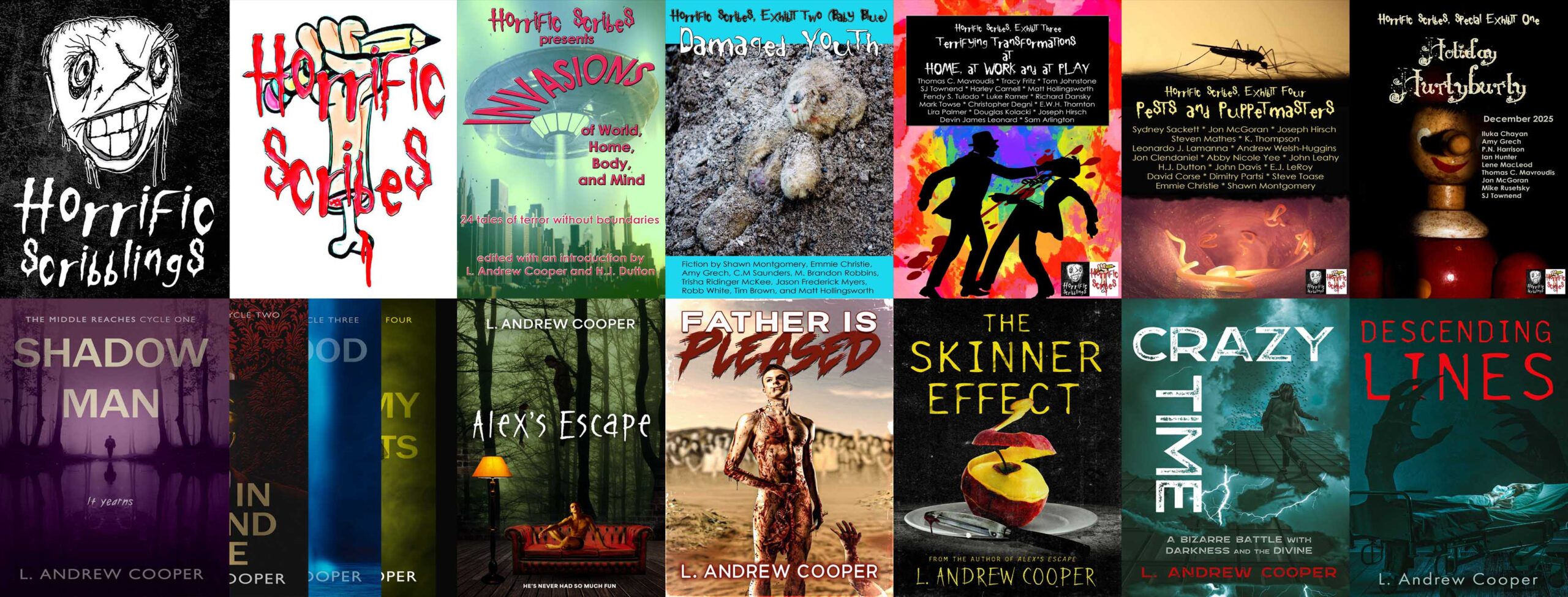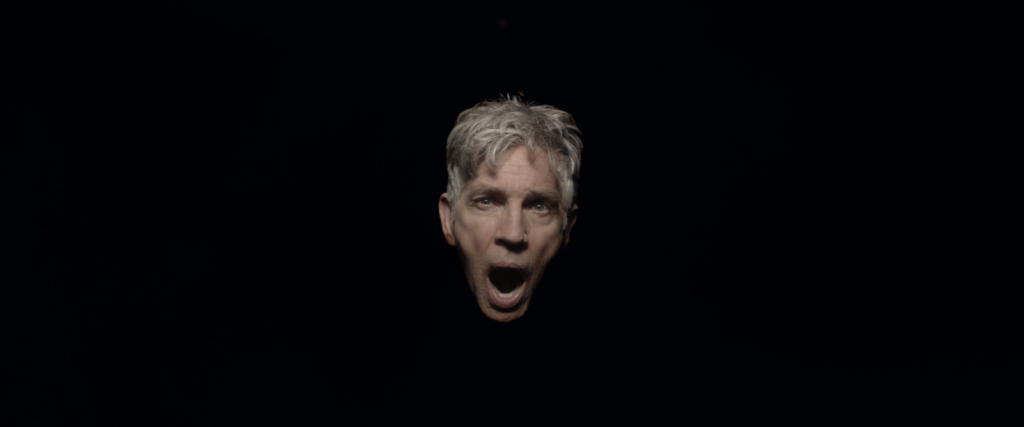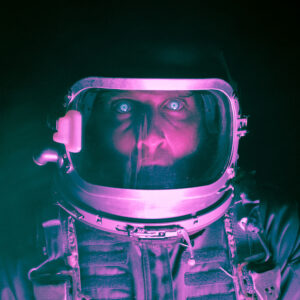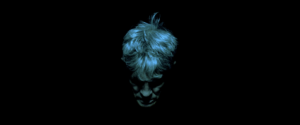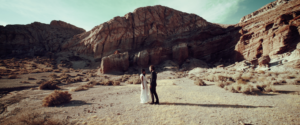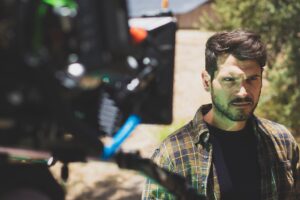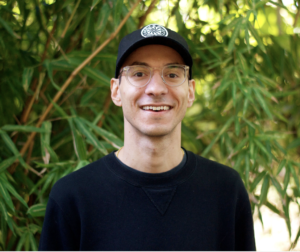Interview with Filmmaker Jason Georgiades: Beneath the Green (2023)
Talented director/producer/writer/editor Jason Georgiades discusses his experimental dark sci-fi film Beneath the Green, now streaming on Amazon Prime.
Beneath the Green
Six lost astronauts seek a way out of a planet that should be dead. Waking up on the forested planet of Anthemusa, Caleb (Anthony Nikolchev), the newcomer of the group, can’t remember how or why he landed on a planet that, up until his arrival, was covered in dry sand. He meets a group of colonists led by Hunter (Veronica Wylie) who encountered the same problem but have yet to find a way out. Making matters worse is the disappearance of their mission commander, Victor (Eric Roberts), who appears to the team in the form of a floating head speaking in cryptic riddles and phrases. Believing that Victor has found a way out, the team searches for “the door”—an image that appears to them during meditation. Learning how to meditate, Caleb uses the technique to track down Victor, who speaks to the team from an unknown location that contains the mysterious “door.” When the team catches up with Victor, they find more than a way out.
The Interview
(1) Beneath Many Mysteries. A planet that isn’t what it should be, a cryptic floating head, a door that appears during meditation—your characters find the world of Beneath the Green mysterious, perhaps baffling, and some audience members might feel the same way, at least at first. What do you hope to accomplish by layering so many mysteries into your film, and how do you think viewers generally respond to immersion in such an enigmatic atmosphere?
JG: I think “layering” is the right word, connected to the profound ability of films to contain multiple levels of understanding with repeated viewings. The key is to allow the film to evolve as it wants. I often feel like a conduit for ideas, a radar tuned into floating puzzle pieces of information that I feel compelled to capture, condense, and display. Sometimes it comes out as profound, confusing, even a little scary to me, but as an artist, I need to trust that output and let the film lead me. I also like the word “mystery;” it makes me think of magic. I see the trick being performed, but I don’t know how it’s done. That’s a beautiful thing to me, but not necessarily to others. Many people want to know how it was done; they don’t want to be tricked or confused. It can be a painful experience, and we often seek clear answers or objective reasons. We have a hard time leading with our hearts rather than our heads. Art and filmmaking, to a large extent, are about embracing the unknown and letting our hearts guide us to a deeper understanding of ourselves that we would never know if we hadn’t looked at that Francis Bacon painting or entered that James Turrell installation. The moment we gain a deeper insight into our true selves can be terrifying but also liberating through the process of experiencing art and film. Therefore, if someone is confounded by Beneath the Green, I welcome that reaction as much as any other.
(2) Meditative Technique. Your film’s description emphasizes meditation as a crucial part of the story, which suggests that significant parts of the characters’ journeys are inward. What techniques do you use to represent inward developments and discoveries onscreen? The film has a dark tone; I’d call it “dark sci-fi,” perhaps adding “with horror elements.” Would you describe the characters’ journeys, inward and otherwise, as fundamentally dark? Why or why not?
JG: Meditation is a significant part of my life, taking different forms over the years. Currently, I’m doing a lot of focused breathwork exercises that take me on inward journeys of self-discovery. Regardless of the form, I generally start “seeing” and feeling things—images, usually abstract, combined with emotions ranging from agitation to calm. These images and emotions are strung together like a string of pearls emerging from a deep ocean, in various shapes and sizes. I’ve attempted to translate that experience on screen every time someone starts to meditate in the film. The sequences that follow are visual abstractions of that subjective experience that lies beyond pure objective analysis. The darkness of meditation could be comforting to others who find that this darkness is beautiful and not threatening. In this context, we sometimes trap ourselves in semantic analysis of images to derive meaning, which, in my opinion, should never happen during meditation. This is why meditation is beautiful; it is an experience to be felt, not understood. The images and emotions should have no labels. To define them is to undermine their purpose entirely. The first line in the Tao Te Ching is, “The Tao that can be told is not the eternal Tao.” In other words, to attempt to describe this vast “source” of life that appears during meditative practice is impossible using words or objective analysis.
(3) Genre Color. In our correspondence, you mentioned your impression that “audiences are a little more open to experimentation in horror and sci-fi.” Generally, I think you’re right. What do genre conventions allow you to do with sounds, images, and concepts that you couldn’t do in a “realist” or non-genre film?
JG: When people walk into a museum, they have been conditioned to understand that as soon as they enter, they’ll probably see unconventional things. Similarly, thanks to the fantastic evolution of horror and sci-fi filmmaking over the past decade, audiences of these genres come to expect that what they are about to see might be unconventional. So, I prefer to screen for audiences open to our film’s unconventional imagery and tone. Some elements of Beneath the Green qualify as “horrific” or “dark,” aligning with these audience expectations. I believe it was a happy coincidence that the film became very dark and evolved in that way, as I certainly didn’t expect it to. I’m grateful that it did!
(4) Experimental Influence. You also mentioned experimental filmmakers as influences—Maya Deren, Kenneth Anger, Stan Brakhage, Andy Warhol, David Lynch (early work), and others. Would you describe some examples of moments in Beneath the Green where specific influences creep in?
JG: I fell in love with cinema through these artists, and sometimes I feel obliged to honor them by using their techniques in my own work. It’s impossible for me to fully account for all the specific references in the film, but ones that stand out to me are references to Andy Warhol’s screen-print paintings. If you look at his self-portrait work from 1986, I think you’ll notice some similarities but also differences. The screen-printing techniques he used directly speak to the effervescent and disposable nature of fame. When I experience Warhol’s work, I feel a kind of disconnect between the man himself and the representation of the man. The idea of Warhol as a celebrity defined by our culture versus the reality of Warhol as a human being. In our film, this extends to the idea of Victor (played by Eric Roberts) as an abstract leader and member of a team versus the reality of who he really is to us and the characters around him. I’m also inspired by these experimental artists’ pioneering sensibilities. The 1970s produced some remarkable artists of all kinds, from The Ramones to David Lynch. They were unapologetically bold in their creative choices, and I love that fearlessness. I want to thank my former teachers, J.R. Hughto, Delanie Jenkins, Lenore Thomas, and Bill Judson for introducing me to these wonderful artists over the years, and my mother, Lydia Contis, for her unwavering support in nurturing my profound passion for the arts. Lastly, I have to thank my wife, Rosita, who has given me the courage and self-confidence to continue making art that feels true to me. I fell in love with her when we were dating because she gave me the only brutally honest review of an early cut of the film during editing! I said to myself, “I’ve got to marry this girl!” And I did! She’s a great author and artist in her own right, and I can’t wait to see what she has in store down the road.
(5) Beyond the Green. Speaking of experimental touches, your film uses a striking color scheme. What colors do you favor and why? How do colors function in relation to narrative, character, subtext, mood, and other aspects of the work?
JG: Thank you for the kind words. Narratively, it was important for audiences to distinguish between the different versions of Anthemusa, as there is a lot of discussion surrounding the different versions. We have the present version of the planet painted in purple and the past or ancient version in green. We also have an “inner” version of the planet in gold that we see at the end of the film. I “see” a lot of colors during my meditations, so I also tried to express that visually in the film.
(6) Narrative Expectations. In our correspondence, you also mentioned questioning audiences’ need for narrative resolution even while understanding that we don’t get such resolution in life. I get the impression that, while you play with genre conventions, you’re not interested in delivering a conventional narrative. Avoiding spoilers, what sorts of narrative risks do you take? What’s satisfying about being risky?
JG: I think there was a point where the film wanted to move in experimental directions that made me very nervous as a narrative filmmaker. Any section in the film where it starts to move away from a conventional narrative could be viewed as taking a risk that alienates the viewer. So, you start thinking, “If it’s not a conventional ending, will people hate it?” But I believe very strongly in the power of making bold artistic choices that try to evoke something new, even if people may not like the taste at first. Filmmaking feels a bit like alchemy, where we’re trying to create gold from crude materials. In this case, we have these raw elements of filmmaking, such as cameras, scripts, lights, and editing systems, that somehow combine to create the visual magic we call “cinema.” So, you feel like a mad scientist, crossing wires together in different ways to create an uncanny experience. I don’t think it is the artist’s job to replicate other films; it’s our job to venture.
(7) Beneath the Text. You cite “general philosophy” and “specifically Taoism” as inspirations for the film. What specific philosophical quandaries do characters confront, and/or what philosophical questions do their situations raise? How does Taoism fit in? Is this the kind of movie that viewers should prepare to discuss, perhaps argue about, in a bar or café afterward?
JG: My co-writer Chet Vincent and I discussed Taoism and the principles behind one of the most widely misunderstood philosophies in the world. The term is often used in various ways and is sometimes incorrectly used to justify a “laissez-faire” attitude toward life, where one believes that if they do nothing, things will work out. “Go with the flow” is a popular catchphrase derived from Taoist principles, emphasizing doing what feels natural instead of constantly forcing things. The core philosophy originates from the Tao Te Ching, a text that academics and poets have dissected and interpreted in their own ways for hundreds of years. To me, this book feels like a reference guide for living. Whenever I face critical points in my life and don’t know what to do, I can find answers in the book. We never attempt to claim expertise in Taoist philosophy, but this fact should not deter anyone from exploring the text in their own way. In our case, we chose film as a mode of exploration. We aimed to capture some of its essence in the film with nods to nature, the balance of life, and references to the great “source.” Meditation is a tool that Taoists emphasize as a means to connect with this source. They believe that when we pass away, we return to this great source or void, and we believe that this is the journey Caleb (played by Anthony Nikolchev) undertakes throughout the course of the film. We are a unique species in that we are given the power to think, something unique to humans. Questions arise: Why are we endowed with the power to think when animals are not? Does the planet think? Does it dream? Are we the planet’s dreams or possible hallucinations? What happens if we don’t fulfill our self-imposed expectations in life? How do others perceive our actions? How do we overcome past traumas, and why do we cling so strongly to the past? Does any of this matter? All these questions can be explored through the lens of the Tao Te Ching, especially through the parables of Zhuangzi. In the end, I believe the film should remain open to interpretation and can be enjoyed without this specific context. This interpretation exists on another level, which contributes to the multi-layered aspect of the film. You don’t have to be a Taoist philosopher to appreciate this film!
(8) Access! How can people learn more about you, view your films, purchase your films, and generally get access to your world (please provide any links you want to share)?
JG: All our art, films, and contact information can be found on our website! Visit http://www.powerplantfilms.com to see what we’re currently working on. We’re excited about our upcoming short film, “Crickets,” which we’ll be filming next year. Additionally, we have two other documentary features set for release in 2024. Head over there for the latest updates!
I would also like to thank you, Andrew, for taking the time to reach out. It’s an honor to be interviewed by such a distinguished writer like yourself. I was a bit nervous about this! I’m deeply humbled by your interest and appreciate your efforts on this website to help artists share their message. It’s a valuable service for all of us, and we can’t thank you enough for the work you’re doing here. Also, a shoutout to Miami International Science Fiction Film Festival organizer, Troy Bernier, for connecting us.
About the Artist
Jason Georgiades is a Greek-American film director from Pittsburgh, Pennsylvania. He received his B.A. in Studio Arts in 2010 from the University of Pittsburgh and his M.F.A. degree in Film Directing from the School of Film and Video at the California Institute of the Arts in Valencia, CA. Starting with his internship at Warner Bros. music group, Mr. Georgiades continues to produce content exclusively designed for online audiences and unique niche markets. He has since created professional online content in association with HBO films, Hollywood Reporter, Vice Media, Viceland, Burton Snowboards, Red Bull and Warner Bros. His most notable work to date is the feature length documentary Desert Age: A Rock and Roll Scene History (2016) (distributed by The Orchard). His sci-fi short film “Through Fire She Calls” (2018) is currently screening in traditional short form film festivals and was purchased by Gunpowder & Sky for their online sci-fi YouTube channel “Dust.”
